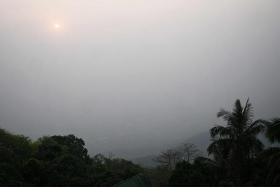Moderate risk of severe haze this year due to rising agricultural commodity prices: Report
There is a moderate risk of severe haze affecting Singapore and the region this year, due to rising agricultural commodity prices that could fuel the expansion of oil palm plantations in the region, a local think-tank said on Tuesday (June 28).
The Singapore Institute of International Affairs (SIIA) , which has a three-point scale for haze risk in the region, said in its annual haze outlook report that there is a "medium" risk of severe transboundary haze this year.
Higher palm oil prices could prompt farmers to expand their plantations at the expense of forests, the report noted. If existing trees are cleared using slash-and-burn techniques, this could result in fires that contribute to transboundary haze.
Moreover, cash crops such as oil palm do not grow well on waterlogged soil. If naturally wet peatlands - large swathes of which are found in countries like Indonesia - are drained to grow such crops, the entire landscape is more susceptible to fire.
The SIIA report noted that the benchmark Malaysia futures monthly price for crude palm oil soared in the first half of 2022, at one point exceeding US$1,940 per tonne.
This is about four times higher than pre-pandemic prices, which hovered below US$500 around mid-2018.
Oil palm seed sales also went up, with growers last year purchasing double the amount than they did in 2018 when palm oil prices were at a historic low.
A number of factors could have contributed to this, the report said.
Lockdowns during the Covid-19 pandemic had reduced supply of the crop. But demand for palm oil is now outstripping supply due to recent events that have reduced the availability of other vegetable oils.
Russia's invasion of Ukraine, for example, resulted in a decline in output from the sunflower oil-producing region. Adverse weather events have also resulted in poor harvests for crops like soya bean and maize in South America.
This is the first time that the SIIA's haze outlook report, now in its fourth edition, has identified market forces as a key contributing factor to haze in the region.
Previous editions had pointed largely to weather as a bellweather for whether the region would experience haze.
Last year's report, for example, found that there was a low risk of severe haze from forest fires, largely due to the La Nina climate phenomenon that brought wet weather to the region.
But the latest report said that even if transboundary haze does occur, it is unlikely that it will be as severe as the haze episodes in 2015 or 2019.
Singapore suffered the worst haze crisis on record in 2015, due largely to drier-than-usual weather caused by the El Nino climate phenomenon, which results in drier weather over South-east Asia.
Recent wet weather in the region, however, could help to reduce the extent of the fires, said Ms Khor Yu Leng, a senior research fellow at SIIA and director of Segi Enam Advisors, an economics consultancy firm, during a press briefing on the report.
The Straits Times had earlier reported that two weather phenomena - La Nina and the negative phase of the Indian Ocean Dipole - will likely bring wetter than average rainfall for Singapore for the June to August period.
However, the SIIA report noted that the region cannot continue to depend on favourable weather to prevent the haze, and permanent solutions would be needed.
Efforts by Indonesia's stakeholders to reduce fire risks have improved dramatically in recent years and already helped to keep the air clear, said SIIA chairman Simon Tay.
The country's deforestation rate in 2020 was the lowest in 20 years, owing to policies such as a moratorium on clearing primary forests and fire-prone peatlands that was made permanent in 2019.
In February this year, its Ministry of Environment and Forestry issued a ministerial decree committing Indonesia to achieving net carbon sink for the forest and other land use sector by 2030.
The SIIA said that other than efforts by the Indonesian government to reduce the extent of the fires, developments in regional carbon markets could also constrain the rapid expansion of cash crop plantations in the future.
For instance, the generation and sale of carbon credits from nature-based solutions also provide market incentives to keep natural landscapes intact.
Each carbon credit refers to one tonne of carbon dioxide emissions, and emitters that are unable to cut their emissions at the source could reduce their carbon footprint by essentially paying someone else to reduce emissions on their behalf.
"It remains to be seen how the nascent carbon project sector will develop in the Asean region, but for the moment the signals are promising," the report said.
Get The New Paper on your phone with the free TNP app. Download from the Apple App Store or Google Play Store now

